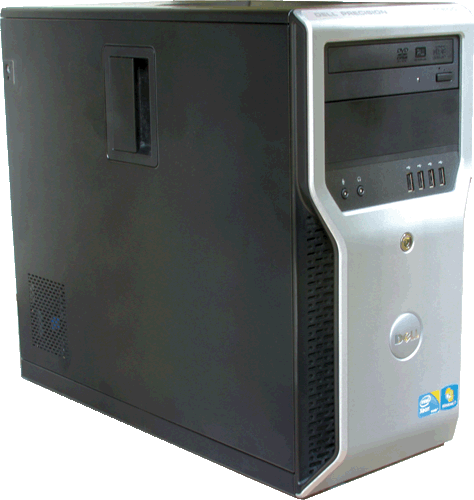Plenty of Power at an Attractive Price
The entry-level Dell Precision T1600 workstation proves that performance can be affordable.
December 4, 2001
By David Cohn
Entry-level workstations are one of the hottest market segments these days, perhaps attesting to tough economic times. Addressing the needs of budget-conscious design professionals, Dell has introduced its Precision T1600. This single-socket workstation is purpose-built for professional 2D and entry-level 3D applications, and is independent software vendor (ISV)-certified for AutoCAD, Pro/ENGINEER and other select software applications.
Based on Intel second-generation Core and Xeon processors, with a choice of Intel HD or add-in professional graphics from AMD and NVIDIA, the Precision T1600 comes housed in a gray and black, tool-less small tower chassis measuring 6.73x17.64x14.25 in. and weighing just 20 lbs. The T1600 looks like a scaled-down version of the T5500 we reviewed early last year (see DE, March 2011).

Like other systems in the Precision family, the front panel provides two 5.25-in. drive bays, one of which came filled with a 16X DVD+/- RW drive. Below these, a sloping panel contains microphone and headphone jacks, four USB 2.0 ports, and cleverly concealed hard drive and network activity lights.
The rear panel hosts a 9-pin serial port, line-out and line-in/microphone jacks, an RJ-45 connector for the integrated Intel 82579LM Gigabit Ethernet LAN, PS/2 mouse and keyboard connectors, and six more USB 2.0 ports. A DisplayPort connector is also provided for those systems with integrated graphics.
Well-organized Interior
Unlike other workstations in the Dell Precision series, the T1600 case opens on the left and reveals a clean, organized interior. A drive cage located near the base of the unit behind the front bezel accommodates up to two 3.5-in. hard drives. Our evaluation unit came with a 3.5-in. 500GB Seagate Barracuda 7200rpm SATA hard drive with a 16MB cache.
| Download the benchmark results. |
A rather small (9-in.-sq.) motherboard provides four memory sockets that can accommodate up to 16GB of RAM. Our evaluation unit came with 4GB, installed as a pair of 2MB 1333MHz DDR3 dual in-line memory modules (DIMMs). The CPU socket occupies the center of the motherboard. You can order the T1600 with one of seven different Intel processors, ranging from a 3.1GHz dual-core i3 up to a 3.6GHz quad-core Xeon E3 processor, including two with built-in Intel HD graphics. Our evaluation unit came with a 3.4GHz quad-core Xeon E3-1270 processor with 8MB of Intel SmartCache.
The motherboard also provides two PCI-Express x16 slots and one PCI slot, all of which can accommodate full-height cards. If you opt to forego the integrated Intel HD graphics, you can choose from among nine ATI or NVIDIA graphic cards. Our evaluation unit came with an NVIDIA Quadro 2000, which provides 1GB of dedicated GDDR5 memory.
Great Performance
Because the Dell Precision T1600 was equipped with just a single quad-core CPU and midrange graphics, we anticipated decent performance, but nothing stellar. Boy, were we surprised. First of all, the system booted up in just 40 seconds—quite fast for a system equipped with only mechanical hard drives.
On the SPECviewperf test, which looks solely at graphics performance, the Dell T1600 turned in impressive results thanks to its relatively fast CPU and NVIDIA GPU. While it certainly didn’t set any records, it proved to be the fastest single-socket system we’ve tested that didn’t have an over-clocked CPU and gobs of memory.
When we turned our attention to the SolidWorks benchmark, which is more of a real-world test and additionally breaks out graphics, CPU and I/O performance separately from the overall scores, the Dell Precision T1600 truly held its own—equaling or outperforming systems costing thousands of dollars more, including several equipped with two CPUs.
On the AutoCAD rendering test, the T1600’s results were again very impressive. With hyper-threading enabled, giving the equivalent of eight processor cores, the Dell Precision T1600 completed our presentation quality rendering in 60.5 seconds—the best result to-date for a system with just one quad-core CPU running at its standard speed.
Prices for the Dell Precision T1600 start at $869. As configured, our evaluation unit priced out at just $1,875. That makes the Dell Precision T1600 a price/performance leader, guaranteed to meet the needs of design professionals without breaking the bank.
David Cohn is the technical publishing manager at 4D Technologies. He also does consulting and technical writing from his home in Bellingham, WA, and has been benchmarking PCs since 1984. He’s a contributing editor to Desktop Engineering and the author of more than a dozen books. Contact him via email at [email protected] or visit his website at DSCohn.com.
MORE INFO
Subscribe to our FREE magazine, FREE email newsletters or both!
About the Author
David Cohn is a consultant and technical writer based in Bellingham, WA, and has been benchmarking PCs since 1984. He is a Contributing Editor to Digital Engineering, the former senior content manager at 4D Technologies, and the author of more than a dozen books. Email at [email protected] or visit his website at www.dscohn.com.
Follow DE





